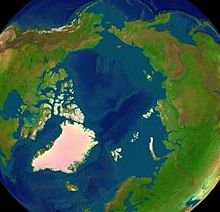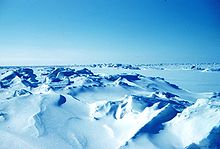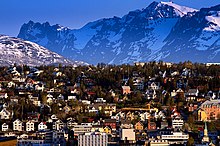The Arctic is the northernmost part of Earth. It can be defined either as everything within the Arctic Circle, or all northern areas where temperature normally stays below 10°C (50°F) around the year; which includes elevated or inland areas south of the Arctic Circle and excludes some areas inside it.




Regions
- United States: Arctic Alaska
- Canada: Yukon, Northwest Territories, Nunavut and parts of Northern Quebec
- Greenland
- A few islets off Iceland
- Norway: Northern Norway, Svalbard and Jan Mayen
- Sweden: Norrbotten County
- Finland: Finnish Lapland
- Russia: Northwestern Russia, Krasnoyarsk Krai, Yakutia and Chukotka
- Islands of the Arctic Ocean
Cities
The Arctic is sparsely populated. Many settlements are or have historically been associated with fishing, whaling (now sometimes replaced by whale-watching), mining, the military or research. Some major centers of population are:
- Bodø, Norway
- Kiruna, Sweden - a mining town
- Murmansk, Russia - one of the most important military harbors of Russia
- Tromsø, Norway - historically a starting point for many Arctic expeditions and one of the biggest cities so far north
- Fairbanks, Alaska
Other destinations
Understand
The Arctic is antipodal to Antarctica. And to get this out of the way: Polar bears: Arctic. Penguins: Antarctica and other places in the Southern Hemisphere. Both: Nowhere but zoos.
Within the Arctic Circle, the sun stays above the horizon during parts of summer (Midnight Sun), and beneath the horizon during parts of winter (Arctic/Polar Night).
Anywhere north of the Arctic Circle is suitable to see the Midnight Sun in Midsummer (all summer if near close enough to the poles) – unless a hill is covering the view – and the Northern Lights during winter.
The sun is low also when seen, 47° above the horizon in Midsummer at noon at the Arctic Circle, 23,5° at the North Pole. There are few truly warm days and temperatures below freezing (32°F or 0°C) are possible even in the summer. Winters are extreme in many areas.
The climate differs significantly by latitude – but also by longitude. Due to the Gulf Stream (from the Sargasso Sea), Scandinavia has a much warmer climate than Alaska, Northern Canada or Siberia at the same latitudes.
Talk
English is the dominant language at international expeditions. Besides national languages (English, Norwegian, Swedish, Finnish and Russian) there are several indigenous languages such as Greenlandic and Inuktitut.
Get in
Regular flights to most big cities – and also regional flights to many minor ones. Some towns, such as Murmansk, have connections by rail, and many regions have decent road connections. Many railways were built with mining goods, not people in mind, so you may be in for a slow and bumpy if usually picturesque ride. There are even four EuroVelo cycling routes to the Barents Sea (to Nordkapp and Kirkenes).
Get around
Scheduled transportation through the Arctic is limited, and travellers need to rely on chartered or private vehicles in most areas. Many places - even what qualifies for cities so far North - are only accessible by boat or plane and even that may be possible only seasonally.
See

- Northern Lights
- Whale watching
- Midnight sun; visible part of the summer.
- Ice and snow — a lot of it and in many places around the year
Itineraries
Do
Eat
Drink
Stay safe
The cold, polar bears, snow blindness and desolation are the main dangers. You can get sunburn too.
See also:
Go next
The only way out of the Arctic is south or to space.
